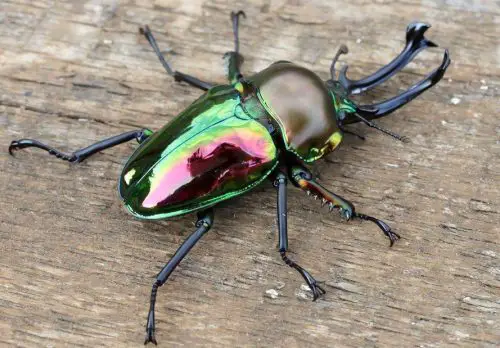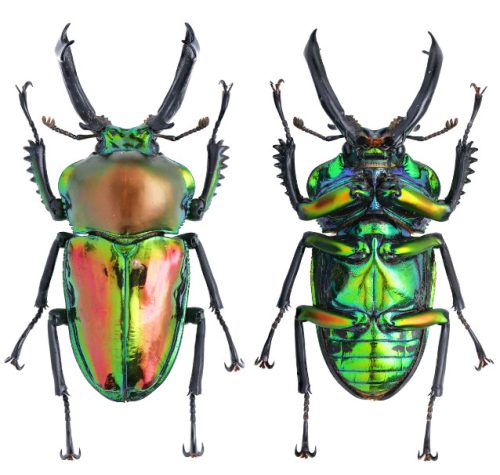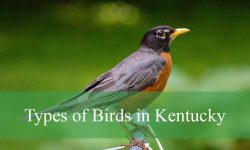Rainbow Stag Beetle, scientifically known as Phalacrognathus muelleri, have become a favorite among insect enthusiasts. From their vibrant appearance to their unique behaviors and intricate care requirements, this guide delves into every aspect of caring for these remarkable creatures.
Whether you’re a seasoned beetle enthusiast or a curious beginner, join us as we explore the intricacies of Rainbow Stag Beetle care and uncover the secrets to fostering a thriving beetle habitat.
About the Rainbow Stag Beetle

The rainbow beetle, whose scientific name is Phalacrognathus muelleri, is a species of beetle belonging to the Scarabaeidae family. This species of beetle is specifically classified as a stag beetle. Native to Australia and New Guinea, these magnificent creatures display a vibrant color palette, giving them their illustrious name.
With a modest size of 2.8 inches (7cm), the Rainbow Stag Beetle has an average lifespan of 12–18 months. Despite their relatively short lifespan, these beetles offer a great opportunity for beginner-level enthusiasts to delve deeper into the world of beetle care and observation.
In their natural habitats of Queensland, Australia, and New Guinea, rainbow beetles prefer to live in the depths of logs, bark, and rotting soil. Their brilliant colors not only make them a sight to behold but also serve as an effective means of identification, especially when they take to the air. Observers will be treated to the spectacle of their brilliant colors as they move effortlessly across the sky.
Feeding on a varied diet of rotting wood, tree sap, nectar, and fruit, rainbow beetles have no trouble finding food in their habitat. However, their bright and attractive appearance becomes a double-edged sword when it comes to survival. While it helps detect them while they are flying, it also makes them vulnerable to predators like birds.
Identifying characteristics of the Rainbow Stag Beetle

Adults
The size of Rainbow Stag Beetles varies with sexual dimorphism. The dimensions of males and females are 24 – 70 mm (0.94 – 2.76 inches) and 23 – 46 mm (0.91 – 1.81 inches), respectively. Their bodies are mostly blue, red, or green, with an alluring metallic sheen, particularly on the back. Their uniform black legs and mandibles serve as a striking contrast.
One of their unique selling points is their obvious sexual dimorphism in terms of physical attributes. In contrast to their female counterparts, male Rainbow Stag Beetles have longer, more curled mandibles and antennae.
Larvae
There are three stages in the larval stage. The larvae display a white, segmented body with an orange face patch when they reach their final stage. They usually live in moist, decaying wood, especially next to white-rot fungi. From larvae to adults, the maturation process takes about three years.
Pupa
After a year in the larval stage, Rainbow Stag Beetles transition into the pupal phase, which is mostly contained in chambers or cells. When they first emerge as adults, their wings are still soft and white; these colors gradually develop over the course of a week.
Eggs
In rotting wood, females deposit about fifty eggs, which hatch after a week. The eggs grow larger over time, eventually exposing the developing larva inside.
How much does the Rainbow Stag Beetle cost?
Acquiring Rainbow Stag Beetles in the US comes with a unique set of regulations, requiring a special permit. Consequently, prices soar, with adults locally costing around $200. In contrast, the global market offers these captivating beetles at a more affordable rate of approximately $40, with a slight increase to $50 for the rare purple specimens.
How does the Rainbow Stag Beetle behave?
Known for spending the majority of their lives underground, Rainbow Stag Beetles prove to be peaceful and harmless, making them an ideal choice for children interested in exploring the world of beetles.
Males, however, exhibit territorial behavior and are prone to aggression. Keeping them together can lead to fights, particularly over the opportunity to reproduce and claim territory. To avoid injuries, it’s advisable to house males separately.
Females, on the other hand, can coexist, and introducing a male for breeding purposes is feasible. Caution is necessary, though, as leaving the male with the females for an extended period may result in the male’s exhaustion or demise.
Handling Rainbow Stag Beetles is generally easy and safe for humans, but the fragility of RSB grubs requires careful handling to prevent accidental drops. While adults can fly, reducing the risk of falling, caution is still essential, especially when handling them near structures that could pose a threat during flight, such as ceiling fans.
Rainbow Stag Beetle Care
Temperature and Humidity
The natural habitat of the Rainbow Stag Beetle encompasses sclerophyll forests and rainforests, environments characterized by elevated humidity and mid-to-high temperatures. Abundant tall trees and lush vegetation create an ideal setting for these captivating insects.
For adult Rainbow Stag Beetles, optimal conditions range between 65°F to 75°F, ensuring their well-being and vitality. In contrast, the grubs, at their larval stage, thrive in slightly warmer temperatures, ranging from 72°F to 77°F. To replicate their native habitat, it is essential to maintain high humidity levels, aiming to keep it consistently above 70%. This commitment to suitable temperature and humidity levels is pivotal in providing a habitat conducive to the health and contentment of Rainbow Stag Beetles in captivity.
Substrate
The substrate needs for adult Rainbow Stag Beetles differ significantly from those of the larvae. Adults thrive in a moisture-retaining substrate that provides a soft texture for burrowing. Mixtures incorporating coconut fiber prove highly effective in meeting their habitat requirements.
On the other hand, grubs have distinct needs, requiring a substrate that serves as both their dwelling and a food source. Providing moist flake soil or kinshi is essential for their well-being.
It’s noteworthy that kinshi, in particular, is considered beneficial for the longevity of male beetles. If within budget, opting for kinshi can contribute to extending the lifespan of male Rainbow Stag Beetles. For optimal burrowing comfort, a substrate depth of around three inches is recommended, ensuring a conducive environment for their natural behaviors.
Tank
During their growth stages, Rainbow Stag Beetle grubs don’t necessitate expansive tanks. Since they predominantly dwell underground, secure containers with ample substrate suffice, ranging from one to two gallons in volume.
For adult beetles housed individually, a tank measuring three times their length, twice their width, and twice their height is suitable. However, to enhance their well-being, providing more space is advisable. Consider a minimum of five gallons if accommodating multiple adults in the same enclosure.
Incorporating hiding spots is crucial for their contentment. Introduce small plants, branches, and bark to create an environment that caters to their natural inclination to seek shelter.
For breeding purposes, include a piece of log in the enclosure, allowing the female to bury her eggs. This addition supports the reproductive needs of Rainbow Stag Beetles and contributes to the overall diversity and vitality of the tank.
Watering
Rainbow Stag Beetles do not necessitate water dishes or open bodies of water within their enclosure. Their hydration needs are fulfilled through their food and the ambient humidity of the substrate. Regularly mist the substrate to maintain adequate moisture levels.
Exercise caution not to overwater the substrate, preventing the accumulation of water at the tank’s bottom. By striking a balance in substrate moisture, you ensure a suitable environment for the beetles without compromising their well-being. Monitoring and adjusting the misting frequency will contribute to creating an optimal habitat for Rainbow Stag Beetles.
Diet & Feeding
Feeding Rainbow Stag beetle grubs is a straightforward process, as they thrive on the appropriate substrate.
Adults, on the other hand, enjoy a diet enriched with sweet fruits like bananas, apples, and grapes. It is crucial to remove any remnants promptly to prevent fermentation, which could lead to fungal issues in the enclosure.
Opting for a food plate with beetle jelly proves to be the ideal choice for adult Rainbow Stag Beetles. These jellies are specially formulated to provide the necessary nutrients. For those on a budget, homemade recipes are readily available online, offering a cost-effective alternative to store-bought options. Ensuring a well-balanced and nutritious diet contributes to the overall health and vitality of Rainbow Stag Beetles in captivity.
Conclusion
We have covered every facet of caring for Rainbow Stag Beetles in this post, including the best habitat and feeding practices. With any luck, this little information will enable you to become more adept at taking care of this amazing insect.






